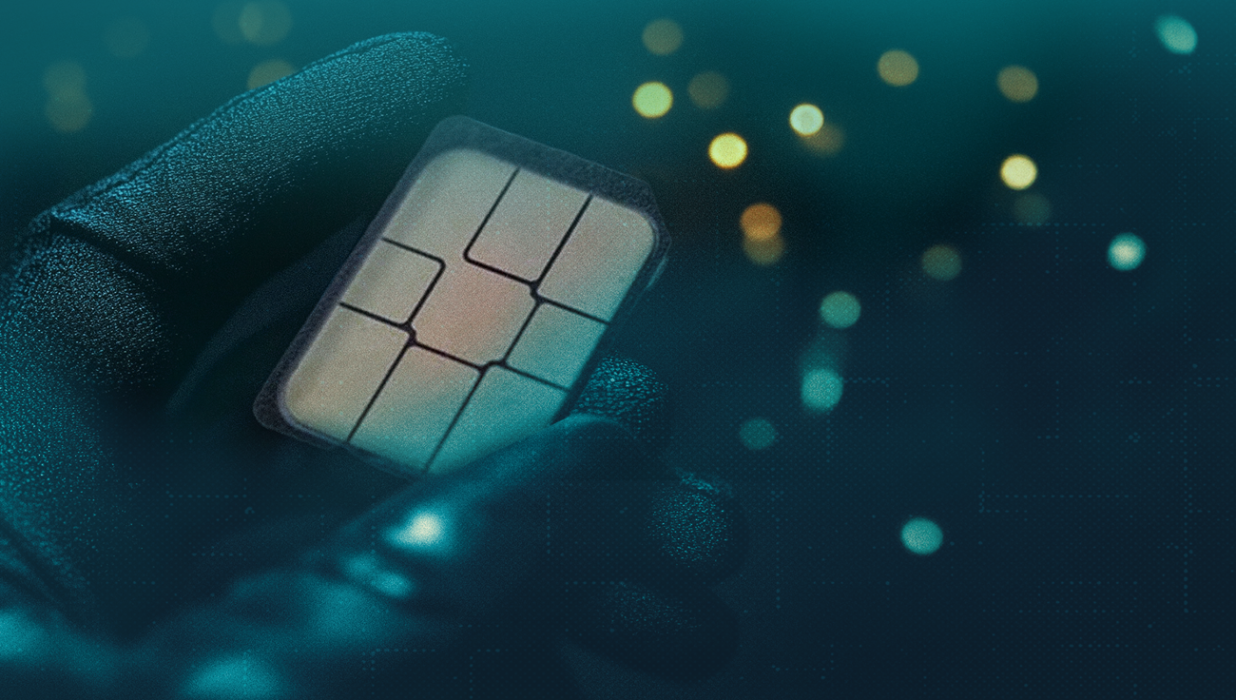You’re at work and grab your phone to check your messages, but something’s off – you have no reception! Coming home and checking again – no difference. Meanwhile, you also start to receive notifications about account changes, including one from your service provider saying how your account’s been activated on another device…
The bad news? You might have become a victim of SIM swapping. The good news? There are some simple ways you can protect yourself. In this guide, we’ll explain how SIM swapping works, and share a few practical steps to keep your accounts secure.
What is SIM swapping?
It all begins with cybercriminals gathering enough of your personal information to convince your mobile carrier to move your phone number to another SIM card. Why? Because your phone number isn’t used just for calls and texts – it’s a gateway to all sorts of places, from banking apps to social media accounts. With your number in their hands, bad actors can intercept your messages, reset passwords, access accounts with SMS-based authentication, and go as far as to steal your money.
Before we dig any deeper: What is a SIM card?
A SIM card (Subscriber Identity Module) is a small device that allows your phone to connect to your mobile carrier’s network. Traditionally, SIM cards are physical chips you insert into your phone, storing essential data like your phone number or carrier information. Their modern replacements are eSIMs (embedded SIMs), which are wholly digital. However, the purpose remains the same: enabling access to mobile networks and identity verification for activities like calls, texts, and two-factor authentication (2FA).
Based on a report from 2024, SIM switch assaults have increased by almost 400% compared to the previous year. The total cash loss incurred by SIM swap attack was almost $49,000,000, according to the FBI’s 2023 Internet Crime Report. High-profile incidents and attacks on celebrities have shown just how devastating this attack can be, though everyday users and businesses are equally vulnerable.
One reason why SIM swapping’s so common is the widespread reliance on SMS-based two-factor authentication (2FA) to secure online accounts. While 2FA is designed to add an extra layer of security, using SMS as the delivery method creates a vulnerability: if attackers gain control of your phone number, they can intercept these authentication codes. This effectively allows them to bypass the added security check, compromising your accounts.
Spotting the red flags: Is your number still yours?
SIM swapping often begins with subtle clues, but it can escalate quickly if unnoticed. Here are some key warning signs to watch for:
- Sudden loss of mobile service: Your phone stops receiving calls, texts, or data without any clear reason.
- Notifications about SIM card changes: Alerts from your mobile carrier regarding SIM updates or account modifications that you didn’t authorize.
- Unusual account activity: Emails or texts notifying you of login attempts, password resets, or new device sign-ins you didn’t initiate.
- Locked out of accounts: You’re suddenly unable to log in to your bank, email, or social media accounts, even with the correct credentials.
- Unexpected changes to account recovery settings: Your backup email or phone number is altered without your knowledge.
- No access to SMS-based 2FA codes: Two-factor authentication codes sent via text never arrive, potentially indicating they’re being intercepted.
If you spot any of these signs, act immediately. Call your mobile carrier to confirm your account status and secure your number. Simultaneously, check your financial accounts for any unauthorized transactions or changes. Next, secure your online accounts. Update passwords, enable app-based 2FA, and check for any signs of unauthorized access.
Also, notify your bank and financial institutions to prevent or recover losses, and don’t forget to report the incident to law enforcement or cybercrime agencies. Quick action can make all the difference.
When it comes to securing your online accounts, the ESET Mobile Security can help you protect your phone with advanced features like Anti-Phishing and a Link scanner to block malicious websites.
Get eset mobile security for android
Dealing with the consequences
One of the most immediate and devastating outcomes of SIM swapping is financial loss. Once attackers gain control of your phone number, they can:
- Initiate unauthorized transactions: By intercepting one-time codes or bypassing two-factor authentication, attackers can drain bank accounts or make fraudulent purchases.
- Steal cryptocurrencies and digital assets: Cryptocurrency wallets, often secured by SMS-based authentication, are prime targets. A single breach can result in significant financial damage – and, as the FBI warns, once the first few cryptocurrency transfers occur, it is extremely difficult to regain these assets.
The financial fallout isn’t limited to individuals though – businesses can also find themselves at risk, with company funds and customer payment details compromised. Beyond the financial toll, SIM swapping exposes victims to significant privacy violations:
- Exposure of personal information: Attackers can access sensitive personal data stored in email accounts or cloud services. This could include medical records, financial documents, or private photos.
- Unauthorized access to communications: By taking control of a victim’s phone number, cybercriminals can intercept private conversations via SMS or even listen to voicemails. This level of intrusion can leave individuals feeling violated.
Finally, in today’s connected world, your online presence reflects who you are. SIM swapping can potentially affect your personal and professional image:
- Misuse of social media accounts: Attackers can hijack social media profiles to post inappropriate or harmful content, tarnishing your reputation.
- Damaged relationships: Whether personal or professional, relationships can suffer when others are exposed to content or messages falsely attributed to you.
For businesses, the stakes are even higher. A compromised social media account or email could damage brand trust, resulting in lost customers and credibility.
Prevention first: How to keep your SIM safe
Protecting yourself from SIM swapping is simpler than you might think. Firstly, strengthen the security of your mobile account. Most carriers allow you to set up a PIN or password that’s required for any changes. Choose something strong and unique – attackers often rely on guessing simple combinations.
But don’t stop there. SMS-based two-factor authentication (2FA), while popular, can be exploited in a SIM swap. Instead, opt for authentication apps, biometric authentication, or hardware tokens, which don’t solely rely on your phone number.
Likewise, oversharing on social media can be a goldmine for attackers. Details like your phone number, address, work experience, or even childhood memories can help fraudsters impersonate you. Keep this information private and stay cautious of phishing attempts – cybercriminals are experts at crafting convincing messages to steal your data.
Beyond these steps, solutions like ESET HOME Security Ultimate provide Identity Protection, multilayered Anti-Phishing (anti-smishing), and advanced malware defense, shielding your personal data from cybercriminals. These tools help detect and block fraudulent attempts before they reach you, offering an additional layer of security against SIM swapping and other online threats.
Expert tips and insights
“The ease of conducting SIM swap attacks and the potential damage they can cause are quite alarming. All an attacker requires are victim’s name and phone number. These can often be found online and combined with additional personal details gathered through open-source intelligence (OSINT) the attacker has everything they need to trick the telecommunications company into transferring victim's phone number to a new SIM card.
Sure, the hacker must pass a security check, but the process usually requires only easy-to-guess information such as part of victim’s birth date or name of their child or pet. If the attackers manage to overcome this basic protection, they can obtain one of the most valuable datapoints we, as users, own.
Being in possession of the phone numbers enables many different attacks, most of which will aim at money, but in some cases, identity theft or extortion might be their end game. SIM swapping technique calls for stronger security measures, like non-obvious PIN codes and more secure 2FA methods. Moreover, it underlines the importance of cyber awareness and the need to take precautionary measures to keep our digital life secure.”
- Jake Moore, Cyber Security Awareness Specialist at ESET
A look into the future
As technology evolves, so do the tactics of cybercriminals. With automation and AI on the rise, social engineering and similar tactics might become more sophisticated.
On the bright side, advancements in authentication technology offer hope. Solutions like biometric verification, multi-factor authentication apps, and hardware tokens are becoming more accessible and widely adopted. These innovations reduce reliance on vulnerable SMS-based systems, creating a stronger defense against SIM swapping.
SIM swapping is a stark reminder of how interconnected – and vulnerable – our digital lives have become. However,the more prepared we are, the safer our digital identities will be.
SIM swapping FAQ
What does SIM swapping do?
SIM swapping transfers your phone number to a different SIM card, allowing the attacker to intercept calls, texts, and authentication codes. This can lead to unauthorized access to your online accounts, financial fraud, and identity theft.
Who is at risk of SIM swapping?
Anyone can be a target, but high-risk groups include individuals with cryptocurrency accounts, banking and financial professionals, public figures, and business executives who may hold sensitive data or high-value assets.
How do you know if you’re a victim?
You may suddenly lose mobile service (no calls, texts, or data), receive unexpected notifications about SIM or account changes, or find yourself locked out of accounts.
What should I do if I think I’m being targeted for SIM swapping?
Act fast. Call your mobile carrier to verify your account and secure your number. Check your financial accounts for any suspicious activity, update your passwords, and enable app-based 2FA. Notify your bank to prevent or recover losses and report the incident to law enforcement to ensure it is documented. Quick action can make all the difference.
Is SIM swapping illegal?
Yes, SIM swapping is considered fraud and is illegal in many countries. Law enforcement agencies treat it as identity theft, and perpetrators can face significant fines and jail time.
Can you stop SIM swapping?
While you can’t eliminate the risk entirely, you can make it much harder for attackers by setting up a PIN with your mobile carrier, using authentication apps instead of SMS-based 2FA, finding a trustworthy security solution for an added layer of safety, and being cautious with personal information and phishing attempts.
Can SIM swapping affect eSIM users?
Yes. While eSIMs remove the need for a physical card, they are still linked to your mobile carrier. If an attacker can successfully impersonate you and trick the carrier into transferring your eSIM profile, the risk remains the same.




